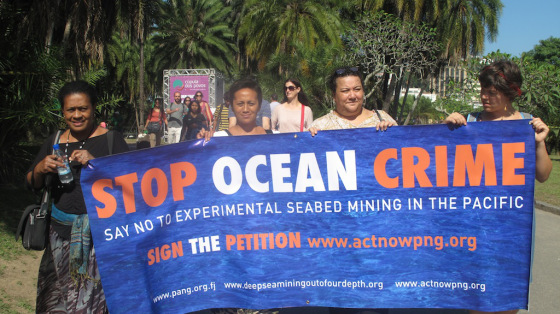
Source: PNG Mine Watch
A controversial mining project that involves ploughing the sea floor off Papua New Guinea (PNG) is set to begin amid concerns about its impact on the marine environment.
Canadian company Nautilus Minerals plans to mine 1.6 million tonnes of copper and gold a year from the volcanic hot springs in the Solwara 1 deposit in the Bismarck Sea, in what is hailed as the first deep sea mining project in the world.
The PNG government has a 15 per cent stake in the mine and is set to reap millions of dollars in royalties.
Nautilus chief executive Mike Johnston said seafloor mining holds enormous economic potential for countries in the Pacific.
"I think this is a real opportunity for these countries, particularly Tonga, Solomon Islands, Vanuatu [and] Fiji, where we've got licences," he told Lateline.
"They have limited potential on land so seafloor mining gives them the opportunity to develop a solid mining industry which has a low environmental impact but produces a high-value product which can generate significant returns."
But PNG campaigners and environmentalists remain sceptical about the company's assurances there will be little impact on sea life such as snails, shrimp and crabs.
Remote-controlled machines will be sent down to churn up the sea floor and the ore will be pumped back up to a ship.
Part of the mining process also involves returning waste water containing elevated concentrations of metals and sediments to the bottom of the ocean.
Project will lead to species extinctions: biologist
One critic is former University of Alaska marine biologist Rick Steiner, who reviewed the project's environmental impact statement for a group of indigenous people in PNG.
"We expect that there will be species extinctions caused by this project," he said.
"I think ethically and morally we have to draw the line in the sand."
He is particularly sceptical about the company's plan to relocate organisms by transplanting parts of their habitat.
"It's sort of like if they're going to clear cut a forest. Would it be worth trying to save a few trees and replanting them and seeing if they will survive? It's worth a try. I think the chances of it succeeding is relatively small."
In 1996, CSIRO scientists were part of an international team that discovered the Solwara 1 deposit and say knowledge about this deep sea environment is still largely unknown.
"There's a huge amount that we don't know about these environments," CSIRO geologist Dr Joanna Parr said.
"There is a lot unknown about the interactions of the various species with each other, the life cycle and how the synergies go between the species."
CSIRO geologist Dr Ray Binns doubts species will become extinct as a result of the mining.
He previously worked as a consultant for Nautilus.
Dr Binns said the volatile nature of the volcanic, hydrothermal environment means the system will restore itself within a few years and the organisms will return.
"The mining's undoubtedly going to kill some animals. That will be a limited loss and the population as a whole will survive," he said.
Nautilus plans to start mining at Solwara 1 in two years.
- Elizabeth1's blog
- Log in to post comments
